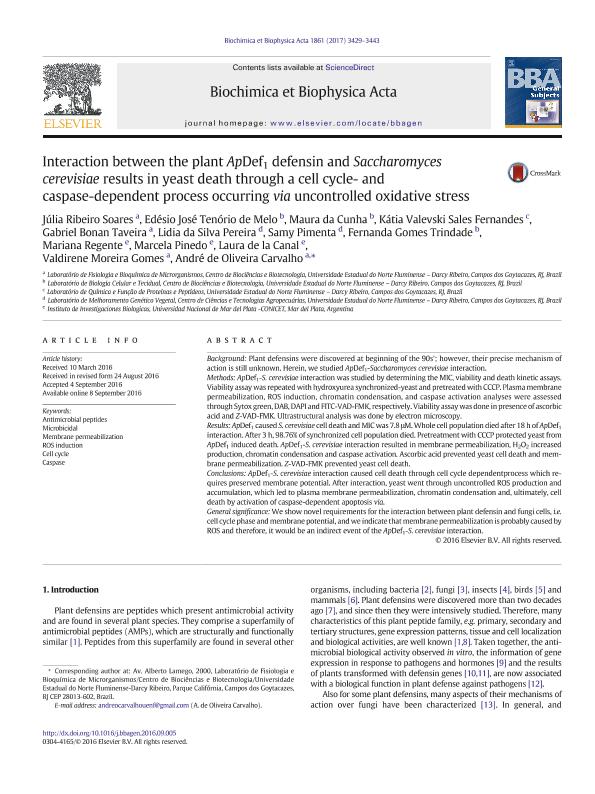Artículo
Interaction between the plant ApDef1 defensin and Saccharomyces cerevisiae results in yeast death through a cell cycle- and caspase-dependent process occurring via uncontrolled oxidative stress
Soares, Júlia Ribeiro; José Tenório de Melo, Edésio; da Cunha, Maura; Fernandes, Kátia Valevski Sales; Taveira, Gabriel Bonan; da Silva Pereira, Lidia; Pimenta, Samy; Trindade, Fernanda Gomes; Regente, Mariana Clelia ; Pinedo, Marcela Lilian; de la Canal, Laura
; Pinedo, Marcela Lilian; de la Canal, Laura ; Gomes, Valdirene Moreira; de Oliveira Carvalho, André
; Gomes, Valdirene Moreira; de Oliveira Carvalho, André
 ; Pinedo, Marcela Lilian; de la Canal, Laura
; Pinedo, Marcela Lilian; de la Canal, Laura ; Gomes, Valdirene Moreira; de Oliveira Carvalho, André
; Gomes, Valdirene Moreira; de Oliveira Carvalho, André
Fecha de publicación:
01/2017
Editorial:
Elsevier Science
Revista:
Biochimica et Biophysica Acta- General Subjects
ISSN:
0304-4165
Idioma:
Inglés
Tipo de recurso:
Artículo publicado
Clasificación temática:
Resumen
Background Plant defensins were discovered at beginning of the 90s' however, their precise mechanism of action is still unknown. Herein, we studied ApDef1-Saccharomyces cerevisiae interaction. Methods ApDef1-S. cerevisiae interaction was studied by determining the MIC, viability and death kinetic assays. Viability assay was repeated with hydroxyurea synchronized-yeast and pretreated with CCCP. Plasma membrane permeabilization, ROS induction, chromatin condensation, and caspase activation analyses were assessed through Sytox green, DAB, DAPI and FITC-VAD-FMK, respectively. Viability assay was done in presence of ascorbic acid and Z-VAD-FMK. Ultrastructural analysis was done by electron microscopy. Results ApDef1 caused S. cerevisiae cell death and MIC was 7.8 μM. Whole cell population died after 18 h of ApDef1 interaction. After 3 h, 98.76% of synchronized cell population died. Pretreatment with CCCP protected yeast from ApDef1 induced death. ApDef1-S. cerevisiae interaction resulted in membrane permeabilization, H2O2 increased production, chromatin condensation and caspase activation. Ascorbic acid prevented yeast cell death and membrane permeabilization. Z-VAD-FMK prevented yeast cell death. Conclusions ApDef1-S. cerevisiae interaction caused cell death through cell cycle dependentprocess which requires preserved membrane potential. After interaction, yeast went through uncontrolled ROS production and accumulation, which led to plasma membrane permeabilization, chromatin condensation and, ultimately, cell death by activation of caspase-dependent apoptosis via. General significance We show novel requirements for the interaction between plant defensin and fungi cells, i.e. cell cycle phase and membrane potential, and we indicate that membrane permeabilization is probably caused by ROS and therefore, it would be an indirect event of the ApDef1-S. cerevisiae interaction.
Archivos asociados
Licencia
Identificadores
Colecciones
Articulos(IIB)
Articulos de INSTITUTO DE INVESTIGACIONES BIOLOGICAS
Articulos de INSTITUTO DE INVESTIGACIONES BIOLOGICAS
Citación
Soares, Júlia Ribeiro; José Tenório de Melo, Edésio; da Cunha, Maura; Fernandes, Kátia Valevski Sales; Taveira, Gabriel Bonan; et al.; Interaction between the plant ApDef1 defensin and Saccharomyces cerevisiae results in yeast death through a cell cycle- and caspase-dependent process occurring via uncontrolled oxidative stress; Elsevier Science; Biochimica et Biophysica Acta- General Subjects; 1861; 1; 1-2017; 3429-3443
Compartir
Altmétricas



